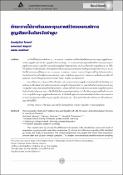บทคัดย่อ
งานวิจัยนี้มีวัตถุประสงค์เพื่อทราบ 1) ความแตกต่างของทักษะการใช้ขาเทียมเมื่อจำแนกตามสาเหตุการสูญเสียขาและระดับการสูญเสียขาของคนพิการสูญเสียขาในจังหวัดลำพูน 2) ความแตกต่างของคุณภาพชีวิตเมื่อจำแนกตามสาเหตุการสูญเสียขาและระดับการสูญเสียขาของคนพิการสูญเสียขาในจังหวัดลำพูน ประชากรเป็นคนพิการสูญเสียขาอายุ 18 ปีขึ้นไป มีภูมิลำเนาในจังหวัดลำพูน เลือกกลุ่มตัวอย่างด้วยการสุ่มแบบแบ่งประเภท เก็บข้อมูลจากกลุ่มตัวอย่างจำนวน 82 คน โดยใช้แบบสอบถามที่พัฒนามาจาก Locomotor Capabilities Index-5 และแบบวัดคุณภาพชีวิตฉบับย่อขององค์การอนามัยโลกฉบับภาษาไทยที่ผ่านการตรวจสอบความตรงจากผู้เชี่ยวชาญและผ่านการทดสอบความเชื่อมั่นจากคนพิการที่ถูกคัดออก วิเคราะห์ข้อมูลด้วยการหาค่าความถี่ ร้อยละ ค่าเฉลี่ย และทดสอบค่าที
ผลการวิจัยพบว่า 1) ทักษะการใช้ขาเทียมโดยรวมจำแนกตามสาเหตุการสูญเสียขาแตกต่างกันที่ระดับนัยสำคัญ .05 แต่ทักษะการใช้ขาเทียมโดยรวมจำแนกตามระดับการสูญเสียขาไม่แตกต่างกัน 2) คุณภาพชีวิตโดยรวมจำแนกตามสาเหตุการสูญเสียขาและระดับการสูญเสียขาไม่แตกต่างกัน แต่คุณภาพชีวิตด้านร่างกายจำแนกตามสาเหตุการสูญเสียขาแตกต่างกันที่ระดับนัยสำคัญ .05 ผลการวิจัยชี้ให้เห็นถึงความแตกต่างของทักษะการใช้ขาเทียมและคุณภาพชีวิตด้านร่างกายระหว่างกลุ่มที่มีสาเหตุการสูญเสียขาที่แตกต่างกัน ดังนั้นทีมฟื้นฟูสมรรถภาพอาจต้องตัดสินใจถึงการแทรกแซงอย่างรอบคอบในกลุ่มคนพิการที่มีสาเหตุการสูญเสียขาที่แตกต่างกัน เพื่อส่งเสริมให้คนพิการมีทักษะการใช้ขาเทียมและคุณภาพชีวิตที่ดีขึ้น
บทคัดย่อ
This research aims 1) to know the difference in locomotor skills classified by causes and levels of
amputation in persons with lower limb amputation, 2) to know the difference in quality of life classified
by causes and levels of amputation. The research population was people with lower limb amputation
who are older than 18 years living in Lamphun. The samples were selected by stratified random sampling from 82 people by using questionnaire developed by Locomotor Capabilities Index-5 and the World Health
Organization’s WHOQOL-Bref-Thai quality of life version. Validity was examined by experts and a reliability
test was obtained from 30 cases excluded from the study samples. Data were analyzed by frequency,
percentage, mean, and t-test.
Results of this research showed that 1) overall locomotor skills classified by amputation causes were
different at the significant level (0.05) but there was no difference in overall locomotor skills classified by
amputation levels; 2) overall quality of life scores classified by amputation causes and levels were not
different but physical domains classified by amputation causes were different at the significant level (0.05).
Research results indicated the differences in locomotor skills and physical domains were by causes rather
than levels of amputation. Thus, rehabilitation teams should design interventions carefully for different
groups of amputation causes, to encourage amputees to have better locomotor skills in prosthetic use and
to have better quality of life.


